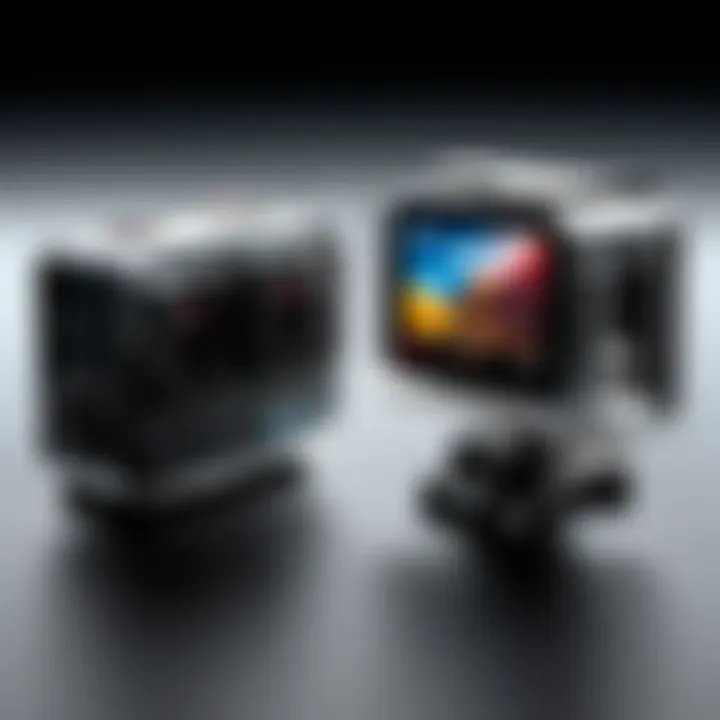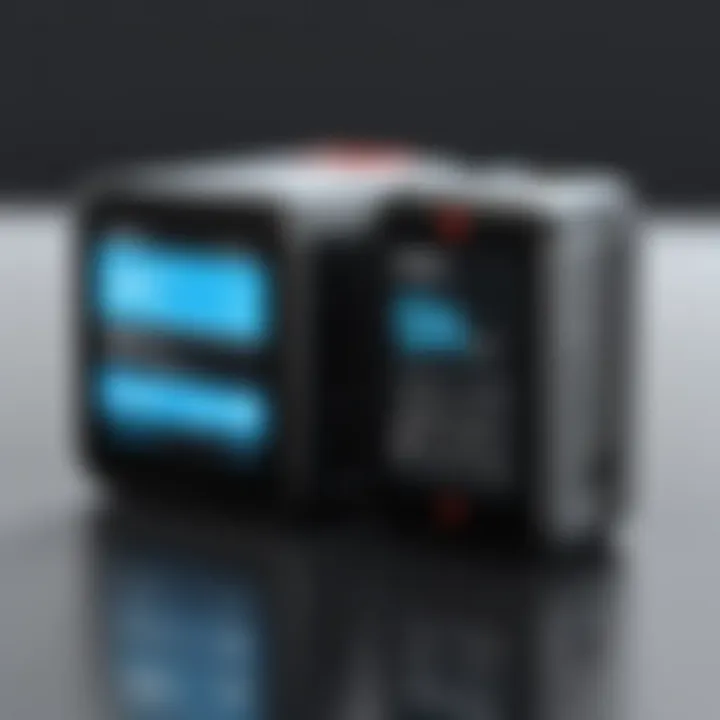GoPro 9 vs GoPro 10: In-Depth Comparison Guide


Intro
The evolution of action cameras has consistently captivated technology enthusiasts. With the rise of GoPro as a leader in this space, the introduction of the GoPro 9 and GoPro 10 models signals significant advancements in user experience and functionality. This comparative analysis aims to uncover the essential differences and advantages of these two pivotal models. Understanding these distinctions enables potential buyers to make informed decisions based on their specific needs.
Overview of the Technology
Key specifications
The GoPro 9 boasts impressive specifications, including a 20MP photo resolution and the ability to capture 5K video at 30 frames per second. It also features a front-facing color display, enhancing usability for vloggers and selfie enthusiasts. In contrast, the GoPro 10 builds on this foundation, offering a more powerful GP2 processor, resulting in improved performance for video recording. This model also supports 5.3K video at 60 frames per second, making it a robust choice for capturing high-resolution action shots.
Unique selling points
The GoPro 9 introduced several market-first features. Its HyperSmooth 3.0 stabilization technology is noteworthy, dramatically reducing motion blur. Additionally, its time-lapse capabilities are enhanced with TimeWarp 3.0, allowing users to create stunning time-lapse videos effortlessly. Meanwhile, the GoPro 10 improves these features further, implementing HyperSmooth 4.0, which provides even better stabilization thanks to advanced algorithms. This updated version is particularly effective for high-speed activities, making it invaluable for adventurers.
Design and Build Quality
Material used
Both models feature a robust and waterproof design, suitable for extreme conditions. The GoPro 9 utilizes a durable outer casing that can withstand submersion in water up to 10m without additional housing. Similarly, the GoPro 10 maintains this standard while incorporating textured grips to enhance handling.
Ergonomics and usability
Ergonomics play a key role in user experience. The GoPro 9, with its enlarged rear touch screen, allows for straightforward navigation through menus. This accessibility is crucial for quick adjustments during live recording. The GoPro 10 inherits this user-friendly interface and enhances it with a more responsive display and smoother operation due to the GP2 processor. This thoughtful design makes it easier for users to manage different settings on the fly.
The GoPro 10's new features make it a compelling upgrade for those needing the latest in action camera technology.
In summary, both the GoPro 9 and GoPro 10 present a strong case for action camera enthusiasts. While the GoPro 9 has laid a solid foundation, the GoPro 10 refines and elevates the user experience with enhanced specifications and usability. Understanding these differences is essential for anyone looking to invest in a high-quality action camera.
Prelude to GoPro Series
The GoPro series has played a significant role in shaping the action camera market. Its innovative designs and technology have allowed users to capture high-quality images and videos in extreme conditions. With each new model, improvements in specifications, features, and user experience keep emerging, reflecting the brand's commitment to meet the evolving demands of consumers.
Historical Context
GoPro was started by Nick Woodman in 2002. It began as a solution for surfers wanting to take photos while riding waves. Over time, GoPro expanded its target audience to encompass a variety of sports enthusiasts and adventurers. From the initial GoPro Hero to the current GoPro 10, the brand has continually upgraded camera capabilities.
The launch of the GoPro Hero 9 in 2020 introduced several enhancements, setting a new standard for what users can expect. With features like improved stabilization and a front-facing display, GoPro 9 received praise for its versatility. In 2021, the GoPro Hero 10 followed, promising even better performance and efficiency, making it crucial to analyze these two models.
Purpose of This Comparison
The core aim of this comparative analysis is to provide clarity on the differences and similarities between the GoPro Hero 9 and Hero 10. Understanding these distinctions is vital for consumers who are contemplating which model to purchase. With technology rapidly advancing, evaluating the practical benefits that each model offers becomes paramount.
Benefits of this analysis include:
- Informed Decision Making: By examining key features, users can make better choices based on their needs.
- Understanding Specifications: A deeper look at technical specifications helps users appreciate what each model can achieve.
- Enhanced User Experience: By recognizing the strengths of each camera, users can maximize their potential uses.
This foundation sets the stage for a deeper dive into various aspects of both models, ensuring readers are equipped with necessary insights.
Design Comparisons
Design comprehensively influences the user experience and functionality of an action camera. GoPro 9 and GoPro 10, while sharing a similar lineage, exhibit notable differences in design that may impact a buyer's decision. Factors such as physical dimensions, weight specifications, and build quality offer essential insights into their performance and usability in various environments.
Physical Dimensions
Examining the physical dimensions of the GoPro 9 and GoPro 10 reveals how form affects usability. Both cameras are compact, ideal for action scenarios, yet the GoPro 10 is slightly refined, granting it an edge in ergonomics. The width, height, and depth differences might seem minor on paper, but they translate to user comfort when shooting for extended periods. Users often appreciate a design that feels secure and manageable in the hands, crucial during high-adrenaline activities.


Weight Specifications
The weight of an action camera can significantly impact its performance, especially during prolonged usage. The GoPro 9 weighs approximately 158 grams, while the GoPro 10 comes slightly heavier at about 153 grams. This might not seem like a significant difference. However, when attached to various mounts or held at arm's length, the difference can impact fatigue levels during activity. Users must consider whether a lighter model gives them that extra comfort during intense adventures.
Build Quality and Durability
A significant aspect of any action camera is its build quality and durability. Both the GoPro 9 and GoPro 10 feature rugged designs, built to withstand outdoor elements effectively. They are rated for water resistance. The GoPro 10 introduces an improved front lens that provides better scratch resistance, addressing a common concern among users who frequently engage in extreme sports. The durability of the device correlates directly to its longevity and can influence the camera's total cost of ownership. Additionally, the GoPro 10 offers enhanced heat management, an important factor during extended recording sessions, potentially adding to its appeal.
The design choices made by GoPro reflect its commitment to creating action cameras that can endure the rigors of diverse adventures while maintaining user-friendliness and functional performance.
Video Quality Evaluation
Video quality is a cornerstone of an action camera's appeal. In today's content-driven world, capturing high-quality video is not just an option; it is essential for both professionals and hobbyists alike. In the context of the GoPro 9 and GoPro 10 comparison, this section evaluates how each model performs in terms of resolution, frame rate, and low-light scenarios, ensuring that users can make informed decisions based on their specific needs.
Resolution Capabilities
Resolution is crucial for defining the clarity and detail in video footage. The GoPro 9 boasts impressive options, allowing users to shoot in 5K resolution at 30 frames per second. This level of detail brings a sense of realism, making it suitable for both cinematic and social media applications.
Meanwhile, the GoPro 10 enhances this capability with a more refined 5.3K resolution. It also supports up to 60 frames per second at this resolution. This advancement is not merely numerical; it translates to sharper images, better color accuracy, and improved overall quality, which is particularly visible on larger screens.
In practical terms, higher resolution means more flexibility. Users can crop or zoom into footage without significant loss in quality. This precision is a notable advantage for content creators focused on high production values.
Frame Rate Options
Frame rates play a critical role in determining how smooth the final video appears. The GoPro 9 allows for variable frame rates up to 240 frames per second at 1080p resolution. This is particularly useful for slow-motion shots, giving users the ability to capture actions in incredible detail, even when they unfold rapidly.
The GoPro 10 takes this further by maintaining smooth performance while also accommodating higher frame rates at 5.3K resolution. With frame rates reaching 120 frames per second in 4K, it offers expanded creative opportunities. Content creators can achieve stunning slow-motion clips without sacrificing resolution, an invaluable feature for those documenting fast-paced sports or vibrant events.
Low Light Performance
A common challenge in video recording is dealing with low-light conditions. Here, GoPro's engineering showcases its innovations. The GoPro 9 performs admirably in dim settings, managing to balance noise and detail reasonably well. However, it does exhibit some limitations as the light decreases, resulting in grainy footage.
On the other hand, the GoPro 10 has been optimized for low-light performance, with notable enhancements to its image processing capabilities. Users have reported significant improvements in low-light conditions when compared to its predecessor. The result is clearer visuals and reduced noise, enabling users to confidently shoot during twilight or indoor events without considerable compromise to quality.
"When video quality is prioritized, the differences between GoPro 9 and GoPro 10 become crucial for serious content creators—especially in resolution and low-light conditions."
In summary, evaluating the video quality of the GoPro 9 and GoPro 10 reveals significant advancements in resolution, frame rates, and low-light performance. These factors directly impact a user's experience and options, guiding them toward a choice that best suits their needs.
Stabilization Features
Stabilization is a crucial aspect of modern action cameras. It directly affects the quality of the footage captured during various activities. Smooth footage enhances the viewing experience and facilitates better storytelling. Both the GoPro 9 and GoPro 10 integrate advanced stabilization technologies that give users the edge when documenting their adventures.
HyperSmooth Technology
HyperSmooth is GoPro's proprietary stabilization technology. Introduced in earlier models, HyperSmooth has evolved into a more refined system in the GoPro 10. This technology utilizes electronic image stabilization (EIS) to reduce shakiness significantly. Users can rely on HyperSmooth for different scenarios, whether it is mountain biking or extreme sports. The GoPro 10 offers an enhanced version called HyperSmooth 4.0, which provides better horizon leveling and smoother playback.
The key enhancements in the GoPro 10 help it to adapt to rapidly changing conditions, ensuring that even in the most challenging environments, users enjoy high-quality video.
"A smooth video can transform raw footage into a captivating narrative, making HyperSmooth a game changer for action filmmakers."
Performance in Dynamic Environments
Dynamic environments can present significant challenges for filming. Whether users are capturing waves crashing, a high-speed motorcycle ride, or other unpredictable conditions, stabilization must hold up. In these situations, both the GoPro 9 and GoPro 10 deliver notable performance.
The GoPro 9 provides adequate stabilization, but it occasionally struggles under extreme motions. In contrast, the GoPro 10 showcases sharp improvements. The advanced algorithms in HyperSmooth 4.0 adapt in real-time to sudden movements, allowing for reliable footage capture even in chaotic settings.
In practical scenarios, this means less time worrying about shaky videos and more time immersing in the experience. Users can trust that their actions, whether they are surfing or skiing, will be recaptured smoothly.


In summary, the ability to maintain video quality during intense activities is fundamental for both casual users and professional creators. Understanding the nuances of stabilization features plays a vital role in selecting the right camera for one's specific needs.
User Interface Experience
A camera's user interface plays a crucial role in its overall usability and functionality. For devices like the GoPro 9 and GoPro 10, this is even more significant because users often rely on quick access to features and settings, especially in adventurous situations. An effective user interface can enhance the shooting experience by making it intuitive and straightforward for both novices and seasoned users.
The design choices made for the user interface can impact everything from how quickly users can switch modes to how easily they can access advanced options. These factors are vital when comparing the GoPro 9 and GoPro 10, as subtle differences in their interface can lead to major differences in user satisfaction and camera performance under pressure.
Touch Screen Functionality
Both the GoPro 9 and GoPro 10 are equipped with touch screens that facilitate interaction. However, the responsiveness and clarity of these screens can vary. The GoPro 10 features an enhanced touch screen that some users may find to be more fluid and responsive than that of the GoPro 9. This improvement allows for better manipulation of settings, resulting in quicker adjustments during action sequences.
The layout of the touch screen is also relevant. Both models implement a similar configuration, where essential functions are displayed prominently. The clarity of icons and the smoothness of the touch interface enhance the user experience. However, the GoPro 10 provides a slight improvement in sensitivity, making it easier for users to select settings quickly without the need for precise taps.
Ease of Navigation
Navigating through menus and settings is another critical aspect of user experience. For action cameras used in dynamic environments, easy navigation is essential. The GoPro 9 provides a robust navigational structure, but the GoPro 10 has streamlined this process further. Users report that they can navigate the GoPro 10 more quickly, with fewer taps needed to reach desired functions.
The organization of the settings menu also plays a part. GoPro has refined its interface in the 10, allowing for logical groupings of features and more intuitive access to video settings, photo modes, and playback options.
"Simplifying the user experience directly affects a photographer or videographer's ability to capture moments as they happen."
Battery Performance
Understanding battery performance is crucial when evaluating action cameras like the GoPro 9 and GoPro 10. The effectiveness of a camera hinges on its ability to maintain power and efficiency during various filming scenarios. Not only does battery life determine how long a user can shoot, but it also impacts the overall experience. Consumers engaged in activities such as adventure sports or travel require a reliable battery to capture key moments without interruption. Thus, examining elements like battery capacity, charging times, and real-world usage duration becomes essential in this comparative analysis.
Battery Capacity
The battery capacity is a fundamental aspect of any action camera's performance. The GoPro 9 is equipped with a 1720mAh Lithium-ion battery, whereas the GoPro 10 features a slightly improved 1720mAh battery as well. The design allows both models to enhance power management while delivering comparable recording times. It is important to note that enhanced firmware in the GoPro 10 may lead to better efficiency in power usage despite similar physical specifications. The battery capacity affects how long users can record, particularly in high-resolution modes. Higher capacity can translate to more extended shooting times, allowing users to focus on their activities without the need to frequently recharge.
Charging Times
Charging time is another critical factor when considering battery performance. GoPro typically provides a USB-C cable for both models, enabling faster charging options. The GoPro 9 takes about 2 hours to charge fully, while the GoPro 10 offers similar results. The similarity in charging time reveals that neither camera holds a significant advantage in recharging speed. However, the adoption of quick charge tech can slightly vary efficiencies, especially in optimal conditions. Users should keep this in mind when planning out media capture sessions, especially where every minute counts.
Real World Usage Duration
Real-world usage duration is vital to understanding the practical implications of battery performance. With the GoPro 9, users can expect around 1.5 to 2 hours of continuous recording, depending on settings such as resolution and frame rate. In contrast, the GoPro 10 often provides a similar effective usage duration, but owners might notice better performance under certain conditions due to firmware reliability and optimizations. Factors such as environmental temperatures, resolution settings, and video modes can significantly affect actual filming times. Therefore, consumers should consider how their intended usage aligns with the available battery life these models provide.
"Battery performance is critical. Understanding these aspects helps extend your documented experiences throughout the day."
Connectivity Options
In the current landscape of technology, connectivity options have emerged as a critical factor in user experience with devices like action cameras. For the GoPro 9 and GoPro 10, effective connectivity capabilities determine how users interact with their devices, share content, and integrate the cameras into their photography ecosystem. Understanding the nuances of these connectivity options is essential for tech-savvy individuals who seek seamless performance while capturing moments on the go.
Wi-Fi and Bluetooth Capabilities
Both the GoPro 9 and GoPro 10 come equipped with robust Wi-Fi and Bluetooth functionalities, foundational elements that enhance the usability of these action cameras.
- Wi-Fi Features: Wi-Fi allows users to connect their cameras to various devices, such as smartphones or tablets, enabling easy content transfer. This connectivity is crucial for those who wish to share their adventures on social media platforms instantaneously, enhancing the overall user experience.
- Bluetooth Functionality: Bluetooth connectivity is designed to establish a stable connection with remote controls and mobile applications, providing additional control and functionality. Users can operate the camera from a distance, which is particularly helpful in dynamic shooting conditions or when the camera is mounted in an inconvenient position.
Both cameras support the GoPro App, which serves as a centralized hub for managing photos, videos, and camera settings. The app delivers features such as live previews, editing tools, and the ability to control the camera remotely. This integration not only simplifies the workflow but also enriches the overall experience, making both GoPro models appealing to gadget lovers and content creators.
Live Streaming Features
The ability to live stream is a pivotal feature for modern action cameras. The GoPro 10 enhances this aspect compared to the GoPro 9, making it a compelling option for users who prioritize real-time content sharing.
- Live Streaming Quality: The GoPro 10 offers improved live streaming capabilities, allowing users to stream in higher resolutions with better streaming quality. This is particularly significant for professionals and streamers who want to maintain high production values.
- Platform Compatibility: Both cameras support popular streaming platforms, but the GoPro 10 is optimized for smoother performance on multiple services. Users can engage their audience more effectively, whether it's through Facebook Live or YouTube streaming.


In summary, the connectivity options of the GoPro 9 and GoPro 10 provide essential features that cater to today’s content creators. With robust Wi-Fi and Bluetooth capabilities along with enhanced live streaming features, these cameras facilitate a versatile user experience, essential for producing and sharing high-quality visuals effortlessly.
Software Enhancements
In the realm of action cameras, software enhancements play a crucial role in the overall user experience and functionality. The GoPro 9 and GoPro 10 both incorporate advanced software elements that significantly enhance their capabilities beyond mere hardware specifications. These enhancements not only improve the camera’s usability but also allow for better post-production, usability, and adaptability for a variety of shooting scenarios.
One of the key aspects of software enhancements is how they streamline the editing process. With increasingly complex video editing needs, both cameras address this by integrating powerful feature sets. These features enable users to effectively manage and refine their footage, which is vital for content creators who need to produce polished videos quickly. This consideration elevates the importance of the editing features incorporated in both models.
Additionally, the evolution of software updates has become more significant with each generation. GoPro has consistently released updates that add new functionalities or improve existing ones, which keeps the cameras relevant amidst rapidly evolving technologies. Thus, the investment in software capabilities is an important aspect that prospective buyers must consider, as it could extend the useful life of the device well beyond its purchase date.
Editing Features
Editing features in GoPro 9 and GoPro 10 reflect the changing demands of content creation. Both cameras allow for high-quality editing right from the device itself. Auto-editing features, for instance, automate the tedious task of compiling footage. Users can leverage intuitive guided editing options to create highlight reels or short clips with minimal effort.
Moreover, GoPro's cloud service allows for seamless uploads and backup. This integration means that users can access their footage from anywhere, making it easier to edit or share on the go. The ability to create advanced edits, apply filters, and add music directly from the mobile application simplifies the process, catering to users looking for efficiency.
Mobile Application Integration
The mobile application of the GoPro cameras enhances the overall user experience significantly. Both the GoPro 9 and GoPro 10 are compatible with the GoPro App, which provides essential functions for managing media.
The app allows remote control functionality, enabling users to control settings or capture images from a distance. This is particularly useful in action-packed or multi-camera setups. Moreover, using the app provides access to live previews, which helps in framing shots accurately before capturing them.
In addition, the application enables users to quickly edit and share their content, making it invaluable for those who prioritize social media sharing. Features like QuikStories automatically compile clips and photos into a short video, streamlining the editing process. Overall, the integration of these software enhancements is vital for users who want efficiency and ease in their content creation.
In summary, the enhancements in software for both GoPro 9 and GoPro 10 are not just add-ons; they are essential tools that elevate the camera's overall functionality, ensuring users can produce high-quality content with relative ease.
Price Assessment
Price assessment is a crucial aspect of this comparison, as it directly influences consumer decisions and perceived value. Understanding price points at launch and current market trends can provide insight into how each model positions itself in a competitive landscape. It also assists buyers in evaluating which camera would be a better return on investment based on their specific needs and budget considerations.
Price Points at Launch
When both the GoPro 9 and GoPro 10 launched, they brought with them price points that reflected their features and capabilities. The GoPro 9 was initially introduced at $399.99, which was consistent with itself as a premium action camera offering. It featured enhanced video quality and improved stabilization technology, aimed at appealing to both professionals and casual users.
In contrast, when the GoPro 10 debuted, it was priced similarly at $399.99. This pricing strategy indicates GoPro's intent to maintain its market share by offering both models at equal price points, thus preventing any drastic shifts in consumer preference. The GoPro 10 offered notably upgraded features such as a more powerful processor, which contributed to better overall performance.
It’s important for potential buyers to consider these launch prices in relation to their respective offerings. Often, launch prices set expectations for performance; however, market dynamics can shift these values over time.
Current Market Trends
Current market trends further illuminate the pricing landscape for both the GoPro 9 and GoPro 10. As technology evolves and new models emerge, older versions like the GoPro 9 have seen significant reductions in their retail prices, often available at around $299.99 or less through various retailers. This decline can entice buyers who desire high-quality action cameras without the burden of a higher price tag.
Conversely, the GoPro 10 continues to hold its value better, typically remaining around its original price. This stability may be attributed to its cutting-edge technology and improvements over its predecessor. Consumers should consider the long-term value of investing in a GoPro 10 if they look for features that maximize utility.
Culmination
The conclusion serves as the final synthesis of our detailed comparative analysis. It is here that the reader reflects on the key aspects of the GoPro 9 and GoPro 10, solidifying their understanding of how each model performs in various contexts. This summary is not just a recapitulation; it provides an essential framework for decision-making. Understanding the pros and cons is crucial for tech-savvy consumers who invest a significant amount of money into these devices.
Summary of Findings
From our exploration, several notable differences and similarities between the GoPro 9 and GoPro 10 have emerged:
- Video Quality: The GoPro 10 boasts an upgraded processor, enhancing overall video clarity and performance in tricky lighting conditions.
- Stabilization Features: Each model utilizes HyperSmooth technology, yet the GoPro 10 offers improved stabilization, making it a better choice for dynamic movements.
- Battery Life: Both models have similar battery specifications, but user experiences suggest slight variations in real-world usage.
- User Interface: The GoPro 10 features notable UI tweaks that streamline the user experience, making it more intuitive.
- Pricing: While the GoPro 9 is often found at a lower price point post-release, the improvements in the GoPro 10 may justify its higher cost for certain users.
In summary, both models are geared toward different user cases, depending on the specific needs for video quality, stabilization, and usability.
Final Recommendations
For purchasing decisions, consider the following recommendations:
- Choose GoPro 9 if you seek a more budget-friendly option that still delivers excellent performance in most scenarios. It meets the needs of casual users and beginner content creators well.
- Opt for GoPro 10 if higher video quality, better stabilization, and enhanced usability are priorities in your filming endeavors. Professional and avid enthusiasts may find the investment worthwhile, especially for high-action activities.
In the end, the choice between these two models should align with your usage preferences and budget. Both cameras offer unique advantages that cater to different segments of the action camera market.







